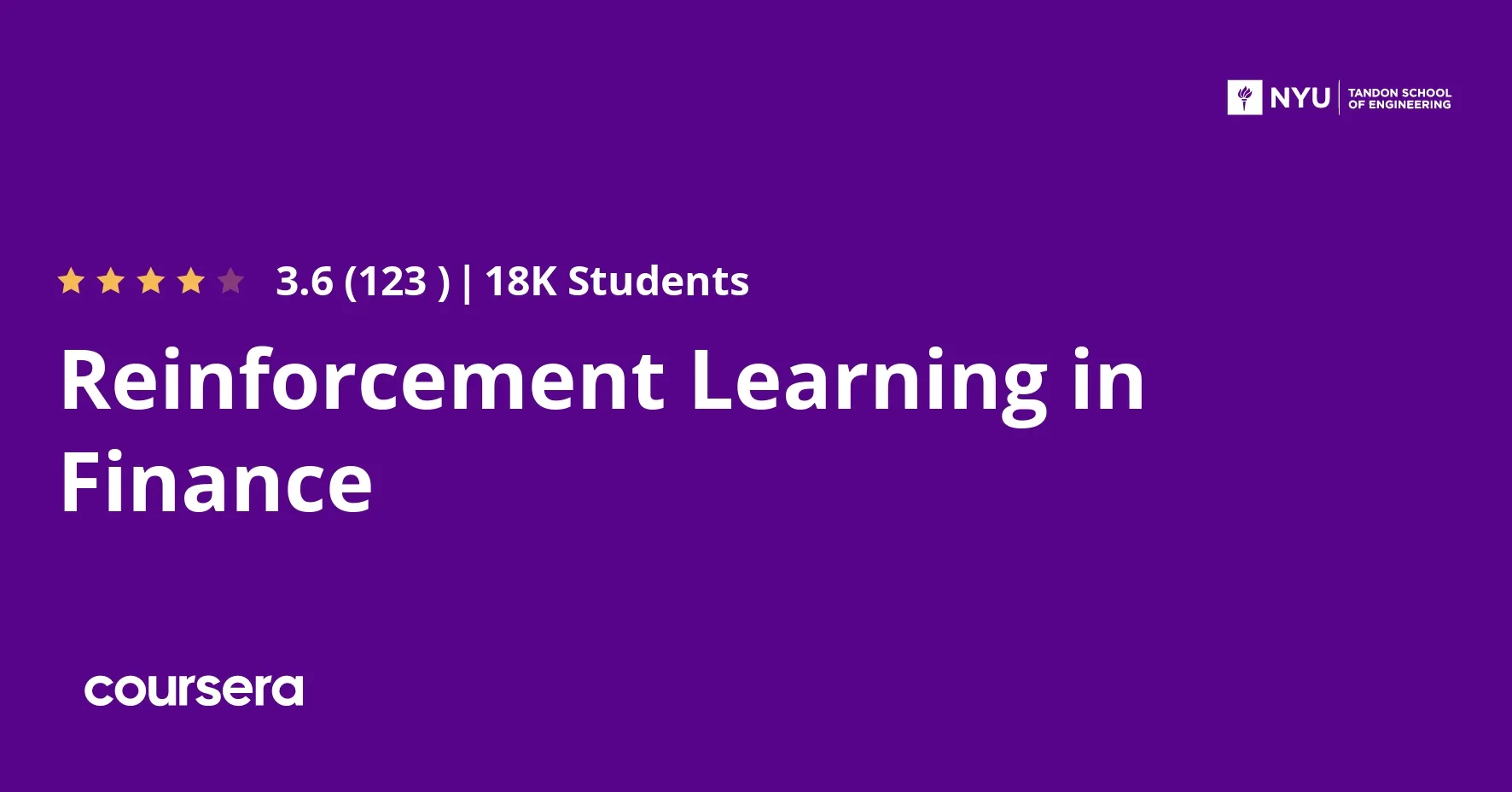
Reinforcement Learning in Finance 
This course provides an overview of Reinforcement Learning (RL) and its applications in finance, such as option valuation, trading, and asset management. Participants will gain an understanding of the fundamental concepts of RL and how to apply them in a financial context. ▼
ADVERTISEMENT
Course Feature
![]() Cost:
Cost:
Free
![]() Provider:
Provider:
Coursera
![]() Certificate:
Certificate:
No Information
![]() Language:
Language:
English
![]() Start Date:
Start Date:
Self Paced
Course Overview
❗The content presented here is sourced directly from Coursera platform. For comprehensive course details, including enrollment information, simply click on the 'Go to class' link on our website.
Updated in [March 06th, 2023]
This course provides an introduction to reinforcement learning in finance. Students will learn how to use reinforcement learning to solve classic finance problems such as portfolio optimization, optimal trading, option pricing, and risk management. Through valuable examples, such as the well-known Q-learning, students will gain an understanding of how reinforcement learning can be applied to financial problems. As the course project, students will apply their knowledge gained in the course to a simple model for market dynamics obtained through reinforcement learning. By the end of this course, students will have a comprehensive understanding of reinforcement learning in finance.
[Applications]
At the end of this course, students should be able to apply their knowledge of reinforcement learning to solve classic finance problems such as portfolio optimization, optimal trading, option pricing, and risk management. They should also be able to experiment with valuable examples, such as the well-known Q-learning using financial problems. As a course project, students should be able to apply their knowledge to a simple model for market dynamics obtained through reinforcement learning.
[Career Paths]
1. Quantitative Analyst: Quantitative analysts use mathematical and statistical models to analyze financial data and develop strategies for trading and investing. They are responsible for researching and developing new models and strategies, as well as testing and validating existing ones. With the increasing use of machine learning and artificial intelligence in finance, quantitative analysts are in high demand and the role is expected to continue to grow.
2. Risk Manager: Risk managers are responsible for identifying, assessing, and managing risks associated with financial investments. They use a variety of tools and techniques, including reinforcement learning, to identify and mitigate potential risks. As the financial industry continues to become more complex, the demand for risk managers with expertise in reinforcement learning is expected to increase.
3. Investment Banker: Investment bankers use financial models and analysis to advise clients on investments and mergers and acquisitions. They use reinforcement learning to develop and test models for predicting market trends and making investment decisions. As the financial industry continues to become more complex, the demand for investment bankers with expertise in reinforcement learning is expected to increase.
4. Financial Data Scientist: Financial data scientists use machine learning and artificial intelligence to analyze large amounts of financial data and develop models for predicting market trends and making investment decisions. They use reinforcement learning to develop and test models for predicting market trends and making investment decisions. As the financial industry continues to become more complex, the demand for financial data scientists with expertise in reinforcement learning is expected to increase.
[Education Paths]
1. Bachelor of Science in Financial Engineering: This degree program focuses on the application of mathematics, engineering, and computer science to the financial markets. Students learn to develop and apply quantitative models to analyze financial markets and develop strategies for trading and risk management. This degree is becoming increasingly popular as the financial markets become more complex and technology-driven.
2. Master of Science in Financial Mathematics: This degree program focuses on the application of mathematics and statistics to the financial markets. Students learn to develop and apply quantitative models to analyze financial markets and develop strategies for trading and risk management. This degree is becoming increasingly popular as the financial markets become more complex and technology-driven.
3. Master of Science in Financial Technology: This degree program focuses on the application of technology to the financial markets. Students learn to develop and apply technology-driven models to analyze financial markets and develop strategies for trading and risk management. This degree is becoming increasingly popular as the financial markets become more complex and technology-driven.
4. Master of Science in Artificial Intelligence and Machine Learning: This degree program focuses on the application of artificial intelligence and machine learning to the financial markets. Students learn to develop and apply AI and ML models to analyze financial markets and develop strategies for trading and risk management. This degree is becoming increasingly popular as the financial markets become more complex and technology-driven.
Course Syllabus
Introduction to the Specialization
Prerequisites
Welcome to the Course
Introduction to Markov Decision Processes and Reinforcement Learning in Finance
MDP and RL: Decision Policies
MDP & RL: Value Function and Bellman Equation
MDP & RL: Value Iteration and Policy Iteration
MDP & RL: Action Value Function
Options and Option pricing
Black-Scholes-Merton (BSM) Model
BSM Model and Risk
Discrete Time BSM Model
Discrete Time BSM Hedging and Pricing
Discrete Time BSM BS Limit
Course Provider

Provider Coursera's Stats at AZClass
Discussion and Reviews
0.0 (Based on 0 reviews)
Explore Similar Online Courses

Agile Methodology

Ethics and Global Challenges Online Course - FutureLearn

Python for Informatics: Exploring Information

Social Network Analysis

Introduction to Systematic Review and Meta-Analysis

The Analytics Edge

DCO042 - Python For Informatics

Causal Diagrams: Draw Your Assumptions Before Your Conclusions

Whole genome sequencing of bacterial genomes - tools and applications

How I would learn Machine Learning (if I could start over)

Learn Data Science and Machine Learning on Microsoft Azure


Start your review of Reinforcement Learning in Finance